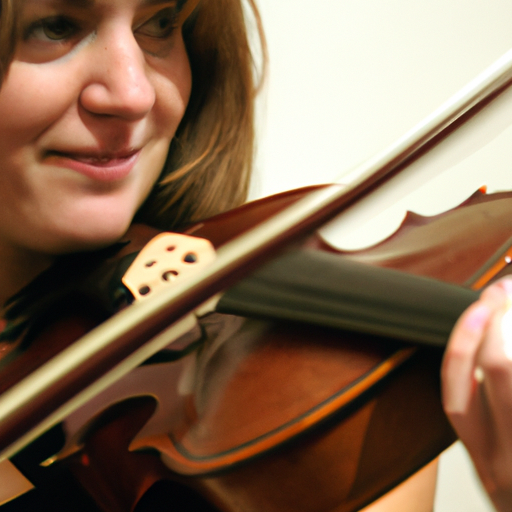
The violin is a beautiful and versatile instrument that has captivated audiences for centuries. Whether you aspire to play professionally or simply want to learn for personal enjoyment, learning to play the violin can be a rewarding experience. Not only does it provide an artistic outlet, but it also offers numerous mental and physical benefits. Playing the violin helps improve focus, memory, coordination, and can even reduce stress levels. In this article, we will explore some simple tips to help you get started on your journey to mastering the violin.

Before you can begin learning to play the violin, it's important to choose the right instrument. When selecting a violin, consider factors such as size, quality, and budget. Violins come in different sizes to accommodate players of all ages. It's crucial to choose a violin that is the appropriate size for your body. An ill-fitting instrument can hinder your progress and cause discomfort.

Quality is another essential aspect to consider. While it's tempting to opt for a cheaper violin, investing in a higher-quality instrument will yield better sound and playability. Try to find a balance between your budget and the quality of the instrument.
It's highly recommended to try out different violins before making a purchase. Visit music stores or consult with a violin teacher who can help you find the right fit for your needs.
Once you have your violin, it's essential to set it up correctly. Proper setup ensures optimal sound production and comfort while playing. Start by tuning your violin using a tuner or a pitch reference. Consistently playing in tune is crucial for developing a good ear and producing pleasing tones.
Next, familiarize yourself with the different parts of the violin. Learn how to properly hold the violin, position your body, and grip the bow for optimal control. A comfortable and relaxed posture will help prevent tension and injury.
Lastly, make sure the bow is rosined adequately. Rosin helps create friction between the bow and the strings, enabling a clear and resonant sound. Apply a thin layer of rosin evenly along the bow hair to achieve the desired effect.
Understanding basic music theory is essential for any aspiring violinist. Familiarize yourself with musical notation, including notes, clefs, and time signatures. Learn how to read sheet music, as it will be your guide when playing different pieces.
Explore the fundamentals of scales and chords. Scales are a sequence of notes played in ascending or descending order and form the foundation of melodies and harmonies. Chords are a combination of multiple notes played simultaneously and provide a harmonic structure.
Take the time to practice sight-reading exercises to improve your ability to read and play music fluently. This skill will enable you to tackle new pieces with confidence and accuracy.
Proper finger placement and bowing techniques are crucial for producing a beautiful sound on the violin. Start by practicing scales, which will help develop muscle memory and finger dexterity. Familiarize yourself with the different finger patterns and positions on the fingerboard.
Experiment with different bowing techniques, such as long bows, short bows, staccato, and legato. Each technique produces a unique sound and adds variety to your playing. Pay attention to the weight distribution on the bow and experiment with different bow speeds to achieve different dynamics.
Additionally, practicing arpeggios and vibrato will further enhance your technique and musical expression. Arpeggios involve playing the individual notes of a chord in a specific pattern, while vibrato adds a subtle and expressive oscillation to sustained notes.
Developing effective practice routines is essential for progress and improvement. Set specific goals for each practice session, whether it's mastering a particular piece, improving technique, or working on intonation.
Use a metronome to develop a sense of rhythm and precision. Start at a slow tempo and gradually increase the speed as you become more comfortable. This will help build speed and accuracy in your playing.
Incorporate repertoire from different musical periods and genres to broaden your musical horizons. Playing a variety of pieces will expose you to different styles, techniques, and musical interpretations.
Proper care and maintenance of your violin are essential to ensure its longevity and optimal performance. Regularly clean the body of the violin with a soft cloth to remove rosin buildup and sweat. Avoid using harsh chemicals or abrasive materials that could damage the varnish.
Check the strings regularly for signs of wear and replace them as needed. Old or worn-out strings can negatively affect the sound quality and playability of the instrument.
When not in use, store your violin in a protective case to shield it from dust, humidity, and temperature fluctuations. Make sure the bow is loosened to prevent warping of the stick.
Learning to play the violin can be challenging at times, and it's important to acknowledge and overcome common obstacles. Hand and finger fatigue are common among beginners, but with regular practice, your muscles will gradually strengthen, and endurance will improve. Take breaks when needed to prevent strain or injury.
It's also normal to experience frustration and a sense of slow progress. Remember that learning an instrument is a journey, and improvement takes time. Stay motivated by setting realistic goals and celebrating small victories along the way.
Seeking guidance from a music teacher, mentor, or online resources can greatly enhance your progress as a violinist. A qualified teacher can provide personalized instruction, correct technique, and offer guidance tailored to your specific needs.
Attending workshops, masterclasses, or joining a community orchestra can also provide valuable opportunities for growth and learning. Surrounding yourself with fellow musicians can be inspiring and motivating.
Learning to play the violin is a fulfilling and enjoyable journey that requires dedication, patience, and practice. By choosing the right violin, setting it up correctly, understanding basic music theory, mastering finger placement and bowing techniques, developing effective practice routines, maintaining the instrument, overcoming obstacles, and seeking guidance, you can embark on a successful violin-playing journey.
Remember to have fun along the way and appreciate the progress you make, no matter how small. With perseverance and a love for music, you can unlock the beauty and expressiveness of the violin.
For more information on learning to play the violin, visit https://bannhacflamenco.net/cho-thue-ban-nhac/luom-lat-tin-do-day/.